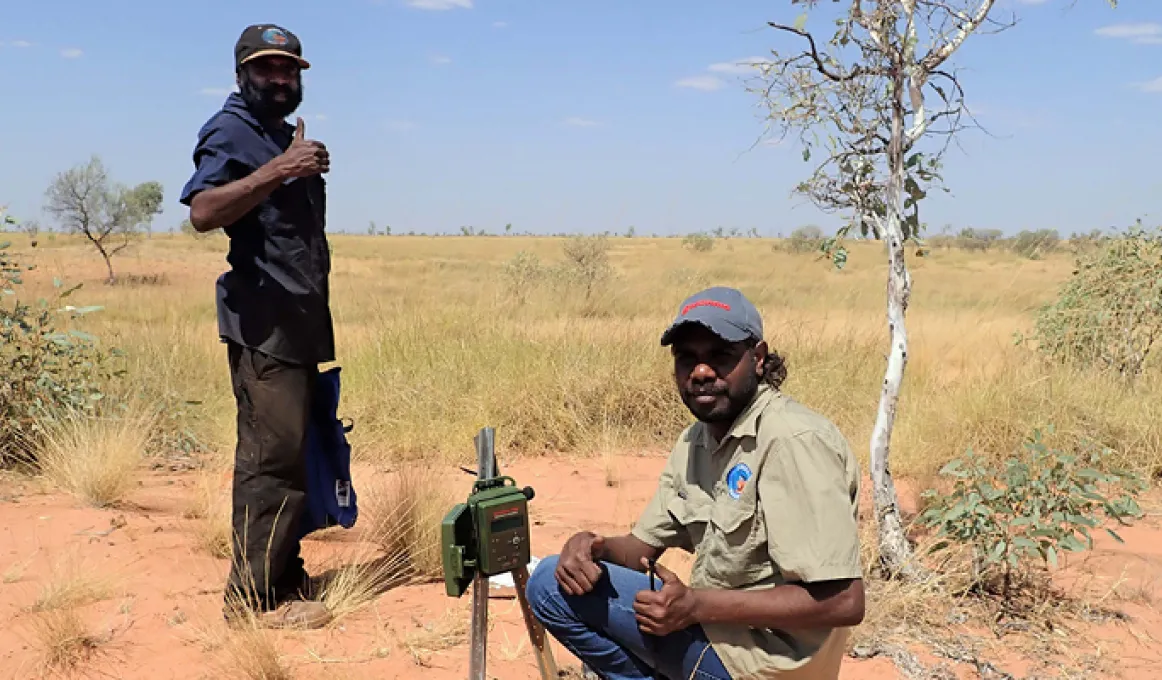Paruku Rangers working hard to preserve the elusive Night Parrot

The Paruku Rangers of the Kimberley recently gained national attention after photographing the critically endangered Night Parrot, not once but twice, in the vast and remote Great Sandy Desert.
Last year, one of the Kimberley’s most isolated ranger teams, the Paruku Rangers, photographed for the second time the critically endangered Night Parrot – a species rarely seen and only rediscovered and photographed by the rangers in 2017.
Paruku Ranger Coordinator Jamie Brown said the second photograph, which captured national media attention, combined with hundreds of audio recordings in the same area, provide further evidence of a Night Parrot population in the Great Sandy Desert.
Since taking the first photo in 2017, the preservation of the Night Parrot has become an important focus of the rangers’ work.
The Great Sandy Desert location of the camera trap image, remains a tightly held secret to protect the population, one of only three known populations where the Night Parrot is known to survive.
‘As custodians for this country we feel very proud to be looking after the Night Parrot,’ Jamie said.
‘Our aim as rangers is to identify where we have a strong Night Parrot population and work intensely to protect that area. We want to look after the Night Parrot for our children and our children’s children.’
The Paruku Rangers are leading the fight to preserve this population and recently brought together Australia’s leading scientists, other rangers and elders for a Night Parrot workshop at Lake Gregory.
The workshop was a great opportunity to discuss the best way of protecting the species.
‘Fire, foxes and cats are the biggest threats to Night Parrots on Paruku Country. We try to stop these threats by undertaking early season burning to reduce the impact of destructive bushfires and putting in place feral management plans,’ Jamie said.
In 2018, the Australian Government awarded the Paruku Rangers $80,000 to continue their work of looking after the Night Parrot and its habitat and also to look after other threatened species such as the Greater Bilby.
The team works across an area of more than 25,000 square kilometres, including the Paruku Indigenous Protected Area (IPA). They are based out of the small Aboriginal community of Mulan on the edge of the Great Sandy and Tanami Deserts, more than 12 hours from Broome.
Tyronne Garstone is Deputy CEO of the Kimberley Land Council which supports the Paruku Rangers.
’What is clear from this latest photograph is that you need Traditional Owners who are on the ground and experts in their country, to help save and look after endangered species,’ Mr Garstone said.
‘Indigenous rangers have intricate knowledge of their country. This comes from generations of dreamings and stories handed down throughout the ages.’
‘If not for the Paruku Rangers and local elders, we’d never know that this population of night parrot existed.’
Jamie said it was also really important to acknowledge those people and groups who have assisted the Rangers.
“I would like to acknowledge my elders, the Traditional Owners of this country. Without them none of this would be possible. They are the backbone of everything we do,” he said.
Find out more
The Paruku Ranger team used the Australian Government’s Indigenous Ranger Program and Indigenous Protected Areas grant funding to deploy bioacoustics devices and cameras in several remote locations by helicopter, confirming continued night parrot presence at the previous site and recording some possible calls elsewhere.
The team look after Tjurabalan Native Title area and greater Paruku region. They are supported in their work by the Tjurabalan Native Title Lands Aboriginal Corporation, the Kimberley Land Council, and the KLC’s Kimberley Ranger Network – an alliance of Indigenous ranger teams across the region.
The Rangers presented on their Night Parrot work at the WA Bird Symposium in August and again at the IDA (Indigenous Desert Alliance) Forum in Perth in November 2018.